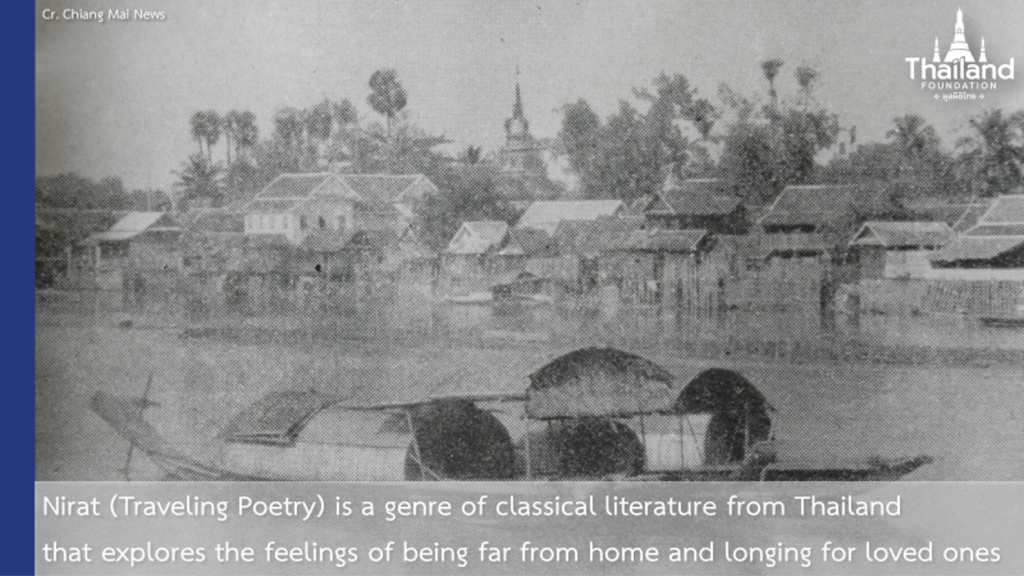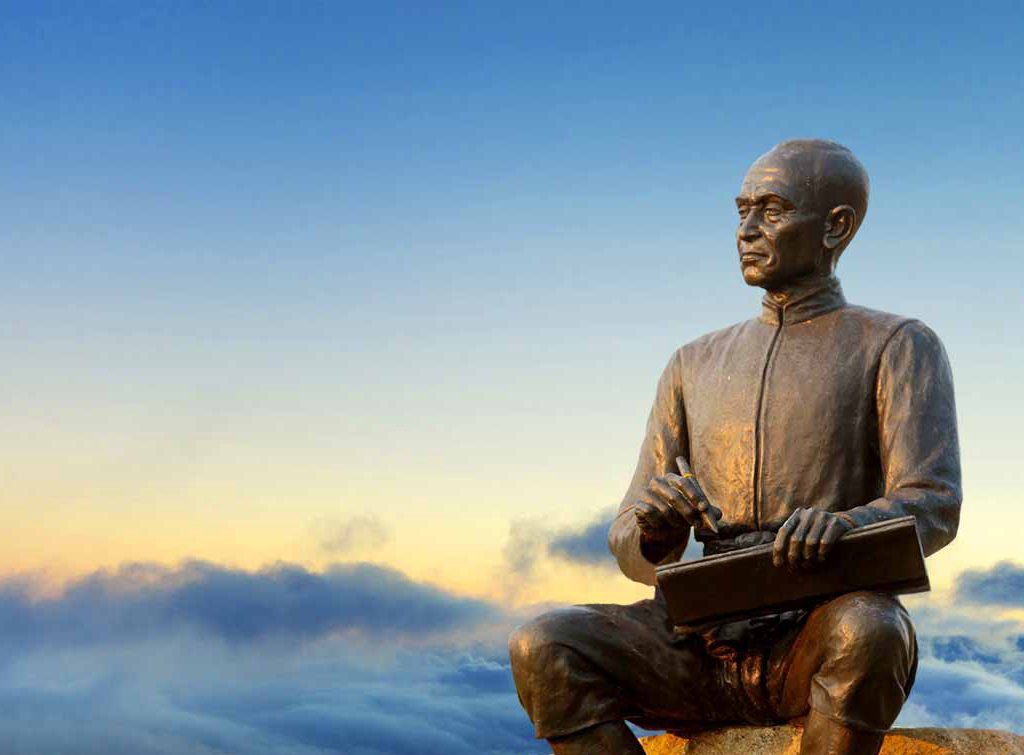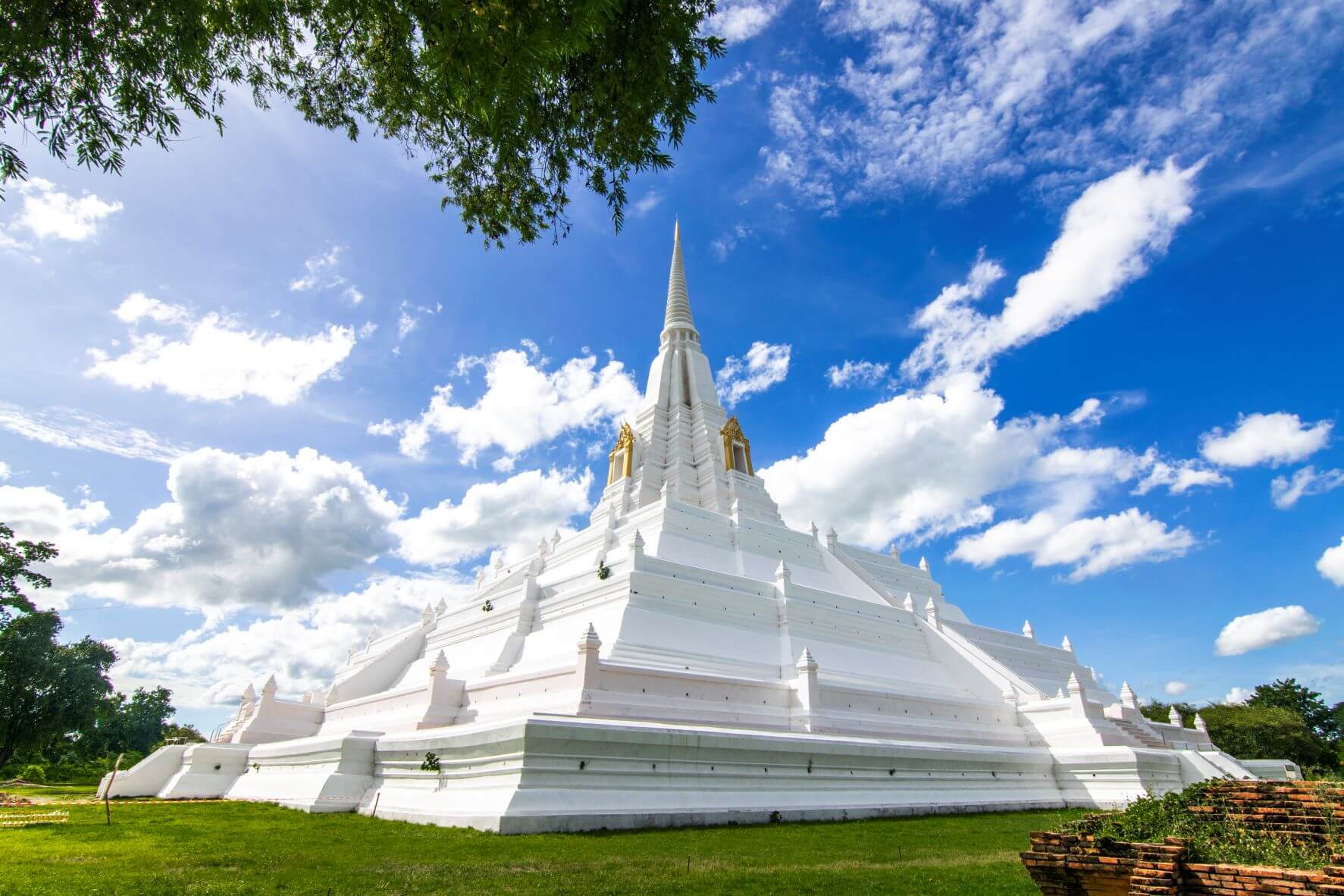Nirat: The Thai Traveling Poetry

Thai literature comprises of works in Roy Krong (ร้อยกรอง) and Roy Kaew (ร้อยแก้ว) formats. Roy Krong refers to poetic works consisting of rhymes and patterned verses. Roy Kaew, on the other hand, are works of prose with no rhyming scheme and meters. Throughout Thai history, Roy Krong works have been important mediums of artistic expression, education, history recording, and entertainment. As such, there are many styles of Thai poetry created to serve various functions. One such poetic style focusses on one particular, yet profound, human experience: traveling. Works from this style explore mankind’s inner contemplations as they embark on journeys to places far away from home. This is the story of Nirat – the Thai Traveling Poetry.
What is Nirat?
Nirat (นิราศ) is a genre of literature written in verse form designated as a distinct type of poetry composed during a journey. The genre is characterized by its expression of longing and sadness from being separated from loved ones, which can be either a real separation, a fictional one, or an imaginative one. There are also examples of non-poetic Nirat that were written in prose; however, these works still keep to the themes of traveling and longing for loved ones.
A Nirat poem can be divided into three sections: the introduction, the journey, and the conclusion. In the introduction, the poet praises the glory of their place of origin. In the journey part, which is the most important, the poet gives details on the excursion, usually by listing the names of the places in the itinerary of the journey while associating those places with the poet’s emotional expressions of melancholy from love separation and nostalgic recollection of his beloved. In the conclusion, the poet might refer to literary characters who also suffer from love separation or leave a message that the poetry is intended to be sent to his loved one.
History
The first poem recognized as Nirat was Khlong Nirat Haripunchai (โคลงนิราศหริภุญชัย) composed by an unknown author during the Ayutthaya period (1350 to 1767). Most Nirat from this period were composed in form of classical Thai poetry called Khlong (โคลง), which was the most popular composing style of the era. Other best-known Nirat works from the Ayutthaya period include Khlong Kamsuan Sriprat (โคลงกำศรวลศรีปราชญ์), and Khlong Thawathotsamat (โคลงทวาทศมาส).
The Nirat genre survived the fall of the Ayutthaya Kingdom in 1767 and continued to flourish during the Thonburi period (1767 to 1782) and the Rattanakosin period (1782 to present). During the Thonburi period, only one Nirat was written – Nirat Guangdong (นิราศกวางตุ้ง) also known as Nirat Phrayamahanuphab Pai Mueang Chin (นิราศพระยามหานุภาพไปเมืองจีน). The piece details the experiences of a diplomatic mission sent by King Taksin’s court to the Qianlong Emperor of Qing China.
Nirat reached its height during the Rattanakosin period, when famed poet Sunthorn Phu invented his own style of Nirat composition. A few Nirat were written before Sunthorn Phu composed his first Nirat, Nirat Muang Klang (นิราศเมืองแกลง). Yet, most pre-Sunthorn Phu Nirat tended to follow the Nirat’s tradition of the Ayutthaya period. Sunthorn Phu’s Nirat works distinguish themselves from their predecessors.

Sunthorn Phu (cr. Anoyama)
Albeit following the three-section organization, Sunthorn Phu preferred composing his Nirat with Klon (กลอน) verse instead of Khlong. This longer form of Thai verse requires different “puns” and rhyming techniques. In his recollection, he also incorporated a significant amount of his personal life experience. His expression of sadness is not limited to that of love separation; melancholy could also be part of his reflections on the scenery. The women in Sunthorn Phu’s Nirat also appeared more realistic than those in the more traditional ones. While Nirat in the Ayutthaya period usually admired the women for their idealized beauty, Sunthorn Phu once described one of his wives as “possessive” and mentioned that her jealousy was a problem in their marriage. This representation was interesting because the poet is openly discussing family problems through his own perspective, instead of using an objectified representation of feminine beauty or a romanticized depiction of his love life to drive his narrative. The popularity of Sunthorn Phu’s Nirat can be attributed to these characteristics. The poet’s most well-known Nirat composition, Nirat Phukaho Thong (นิราศภูเขาทอง), is considered to be the best Nirat work of all time.
Sunthorn Phu’s style set the new Nirat tradition for many poets in the Rattanakosin period to follow, including contemporary local Nirat literatures, namely Nirat Ubon Rachathani (นิราศอุบลราชธานี), Nirat Krung Thep Maha Nakorn (นิราศกรุงเทพมหานคร), Nirat Chiang Rai (นิราศเชียงราย), and Nirat Surat Thani (นิราศสุราษฏร์ธานี).
Nirat’s distinctive theme and narratives allow the genre of literature to survive the test of time and develop its own style throughout history. Nowadays, Nirat remains part of Thai contemporary literature due to its characteristics, with the “expressions of melancholy love-separation” at its core, allowing readers from all walks of life to connect themselves to narratives and the expression of emotions in Nirat.
Understanding the Beauty of Nirat
As a Nirat piece is often composed while the poet is traveling, it can be regarded as a “travel diary” filled with artistic expression of emotions, reflections on past experiences, and observations on the surroundings. For example, Khlong Kamsuan Sri Prat (โคลงกำสรวลศรีปราชญ์) starts with the poet praising the beauty and glory of Ayutthaya, describing the grandeur of the Royal Palace, its garden, and the decorative and tasteful architectural designs of the temples, then expressing his worry and concern about leaving his loved one behind as he embarks on a journey into exile. Then Sri Prat, the poet, lamented his separation from his beloved as he passed different locations.
“As I arrived at Ko Rian, I asked the island to deliver the message to you,
At Ko Khom, I cried for the Khom people to see for themselves.”
Even though most Nirat focus on expressing the sense of longing, poets also wrestle with other emotions that emerge from their retrospection. In Nirat Phukhao Thong (นิราศภูเขาทอง), composed by Sunthorn Phu, the poet reflected on his declining social status and expresses his sadness.
“At Krung Kao my heart became more saddened.
We passed along by the landing of the Governor’s residence,My tears streamed down when I thought of the old days,
I would stop to see him if things were like before.
He would receive me in his house.But now I am poor and if he would act strangely,
What would I do if he laughed at me.”
While reading Nirat, the readers would learn about the poet’s life as much as the poet’s introspection into his emotions. Whether it is love, melancholy, or peace of mind, they are part of human nature that every reader can relate to.
Nirat is also known for its mastery of language, including rhyming techniques, elegant and witful word choices, and its descriptive language. Limited by specific prosodic rules for Thai poetry known as Chanthalak (ฉันทลักษณ์), the authors of Nirat need to employ several techniques and knowledge of the homonyms, synonyms, and words that are homophonous in order to effectively convey their feelings to the readers without violating the rhyme schemes. One of the most common techniques is a specialized technique of “pun” that the poets use to amplify the emotional effects of separation by associating the names of the locale with words that express melancholy.
In Klong Kamsuan Sriprat, the poet uses the technique of a “direct pun” by associating the name of a locale “Bang Chak (บางจาก)” meaning “The Village of Nipa Palm” (“chak” being the name for the Nipa Palm) with another similar word “chak (จาก)” meaning “separation” or “to be separated from”.
“I suffered in anguish and pain,
Until I reached this village of Nipa Palm.Separated we are, beloved, far far apart,
Sobbing and moaning, I called out in vain.”
Some “direct pun” techniques are conventional and can be found across many Nirat pieces from different eras. “Chak” (Nipa Palm, separation or to be separated from) is one of them, which can be found in works such as Klong Kamsuan Sriprat, Nirat Narin by Nai Narin Thibeth (นิราศนรินทร์), and many of Suthon Phu’s works, including Nirat Phukhao Thong, and Nirat Prabath (นิราศพระบาท).
Nirat can also be informative, as it usually contains detailed descriptions of nature. The poet might overcome loneliness in his/her journey by describing the scenery, such as flowers and behaviors of animals in the area. While the poet gives realistic descriptions of nature, he/she also associates those details with his loved one. In Kap Hae Ruea of Prince Thammathibet (กาพย์เห่เรือเจ้าฟ้าธรรมาธิเบศร) of the Ayutthaya period (1350 to 1767), classified as Nirat genre, the prince described the beauty of the flowers he saw during his journey, associating their traits with the beauty of his beloved wife.
“Thickly blooming champa flowers unfold
Their gentle petals in yellow luxuriance
I recall the gold of your complexion
Excelling the magnificence of the golden champa”
Besides the harmonious co-existence of the poet’s personal reflection and description of the surroundings, this genre of Thai literature also serves as a mirror reflecting the social values and Thai people’s beliefs at that time. Many Nirat pieces were written during a journey to a place of worship, such as Khlong Nirat Haripunchai, Nirat Phukhao Thong, Nirat Wat Chao Fa
(นิราศวัดเจ้าฟ้า), Nirat Phra Prathom (นิราศพระประธม), and Nirat Phrabath (นิราศพระบาท). These stories of pilgrimage show that Buddhism as a religion played an important role in the spiritual lives of Thai people in the past. In Nirat Phukhao Thong, Suthorn Phu paid homage to the relic shrine, where he also prayed for a successful, healthy, and happy life.
Mentions of Buddhist concepts such as “karma” can also be found in the personal reflection part of Nirat. In Nirat Phra Prathom, when Sunthorn Phu visited the place his former wife, Nim, used to live, he lamented the nine years of their separation, saying that it was karma that all the living beings must part. Similarly, in Klon Pleng Yao Rueang Rop Phama Thi Tha Din Daeng (กลอนเพลงยาวเรื่องรบพม่าที่ท่าดินแดง), composed by King Rama I, the beginning of the poetry talks about karma as the reason for the King’s separation from his loved one and the city of happiness. Therefore, Nirat shows that Buddhist concepts have always been a part of Thai people’s ways of thinking
Nirat Phukhao Thong: The Best of All Nirat Works
Suthorn Phu’s most famous work, recognized as the best Nirat, is Nirat Phukhao Thong (นิราศภูเขาทอง), written in 1830 during the reign of King Rama III when Suthorn Phu was a monk. As a monk, he traveled to Phukhao Thong Pagoda in Ayutthaya to pay reverence to the Buddha’s relics. The itinerary included many places such as his monastery, Wat Ratchaburana, The Temple of Dawn, the Grand Palace, Bang Thorani, Bang Chak, Samkhok, and Pak Kret. These places evoked Suthorn Phu’s sadness, either about the death of King Rama II, whom he was close to, or about his life after losing favor of the court. This expression of melancholy is rich with emotions and literary beauty. At Bang Thorani, he lamented that:
“I have no land to live in,
Only thorns piercing my heart,how disconcerting to me,
Like a lonely bird without a nest.”
At Samkhok, he wrote:
“When I arrived at Samkhok I sadly remembered
Rama the second, who cared for his region,
Who appointed Samkhok a third-class city
And named it Lotus City for its lotus blooms.
Oh, Lord, you are gone, never to return,
But the name you gave Samkhok ensures its fame.
But I whom you name Sunthon
Am not safe from harm as is that fair town.
The end of your reign brought an end to my name
And I must roam about to find a home.”
Although Sunthorn Phu was quite pessimistic at that time and his self-reflection was filled with discontent and dissatisfaction about life, despite his monkhood, he was able to maintain Nirat’s main characteristic of expressing the feeling of love-longing. For example. At a brewery, he compared the drunkenness of liquor to the drunkenness of love. The former might disappear afterwards, while the latter could stay forever. However, Sunthorn Phu’s expression of love-longing in Nirat Phukhao Thong could not be personal because a Buddhist monk is supposed to refrain from thinking or talking about women or love. Therefore, Sunthorn Phu referred to women with the term “sika (สีกา),” an appropriate term for monks to address women.

Phukhao Thong (Golden Mount) in Ayutthaya Province
(cr. Tourism Authority of Thailand)
Apart from the expression of emotions, Nirat Phukhao Thong also included cultural aspects, social values, and concepts from Buddhist teachings. When Sunthorn Phu traveled past Pak Kret, he described a scene from the Mon people’s village where he saw Mon women who tried to dress like the Thais. His description portrayed Thailand in the 1800s as a multicultural society. At Ban Dua, he commented on the fig fruit, which looked delicious from the outside but was full of insects inside. Likewise, cruel human beings might appear to be sweet on the surface, but bitter inside. In this part, Sunthorn Phu mastered the “pun” technique by playing with the word “Dua” in “Ban Dua” locale and “ma dua,” Thai name of the fig fruit, and comparing the fruit with human nature. At Ban Ngio, Sunthorn Phu referred to the Ngio tree in Buddhist belief, where people who commit the sin of adultery will be punished by climbing the terrifying trees with 16-inch-long thorns in hell.
Eventually, when Sunthorn Phu arrived at the Phukhao Thong Pagoda, looking at the ruins of the once-grand shrine, he reflected on the Buddhist concept of impermanence. The readers of Nirat Phukhao Thong can learn a great deal about Thailand in the 1800s in terms of its landscape, the lifestyles of the people, and their beliefs. Moreover, one might even find Sunthorn Phu’s wisdom about uncertainty in life applicable to their experiences.
Conclusion
Although some parts of Nirat, including the puns and the cultural context, might be difficult to understand for non-Thai speakers, the sense of longing, suffering from love-separation, reflections on the nature of life, and the idea of soul-searching by traveling are timeless and universal. Regardless of their understanding of Thai language and culture, Nirat readers can embark on the same journey as the poet through the vivid description of the scenery and reflect on their own experiences through the lens of the poet. The Buddhist concepts and Thai ways of thinking could open the readers to new perspectives, similar to the experience of traveling to a new place.
Moreover, Nirat readers can learn more about Thai history from the poet’s itinerary. In the case of Nirat Phukhao Thong, the readers can immerse themselves in the poet’s boat trip story. The boat traveling route from Bangkok to Ayutthaya as described in Nirat Phukhao Thong is different from today’s land route, allowing readers to learn about the lifestyles of the people living by the river and those of other ethnic groups living in Thailand at that time. Therefore, some Nirat that are not fictional or imaginative can be regarded as historical accounts as well.
Nirat as a genre of Thai literature weaves together Thai literary beauty, the richness of history and culture, the unique perspectives of Thai ways of thinking, the embodiment of social values and beliefs, the essence of spirituality, and the personal identity of the poet. Its profound expression of emotions and reflections on the nature of life make this genre of literature remarkably humanistic, thus endowing it with a timeless quality that transcends boundaries and resonates with readers from diverse backgrounds. Its enduring presence throughout history stands as a testament to the invaluable significance of Nirat, not only for the Thai people but also for literature enthusiasts worldwide.
The story of “Nirat” is a charming part of Thai culture and heritage. This literary genre showcases the beauty of the Thai language and the insights of Thai writers. Furthermore, its themes of longing, reflection, and being away from our comfort zone are experiences that many around the world can relate to. Join us in exploring more stories of Thailand and the Thai people, as we take you on a journey to discover Thainess.
Sources:
- https://thesiamsociety.org/wp-content/uploads/1972/03/JSS_060_2g_ManasChitkasem_EmergenceAndDevelopmentOfNiratGenre.pdf
- https://eprints.soas.ac.uk/28805/1/10672973.pdf
- https://th.wikipedia.org/wiki/%E0%B8%99%E0%B8%B4%E0%B8%A3%E0%B8%B2%E0%B8%A8
- https://sotci-thaijo.org/index.php/wiwitwannasan/article/view/240410/164393
- https://www.britannica.com/art/Thai-literature#ref846963:~:text=Classical%20literature%2C
- https://so06.tci-thaijo.org/index.php/VANNAVIDAS/article/download/62312/51293/144733
- https://www.thairath.co.th/lifestyle/life/2699992
- http://www.manusya.journals.chula.ac.th/wp-content/uploads/2021/06/15-2.pdf
- http://www.sure.su.ac.th/xmlui/bitstream/id/c7999693-87a7-454c-8e72-4ddd04d7e78d/DR_Nisakorn_Butrngamdee.pdf?attempt=2
Author: Nutcha Suwanmalee
Editor: Tayud Mongkolrat
19 September 2022


